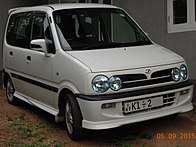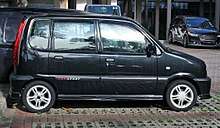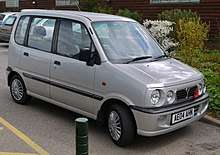Perodua Kenari
| Perodua Kenari | |
|---|---|
_(front)%2C_Serdang.jpg) | |
| Overview | |
| Manufacturer | Perodua |
| Production | 2000–2009 |
| Body and chassis | |
| Class | Supermini |
| Body style | 5-door mini MPV |
| Layout | FF layout |
| Related | Daihatsu Move |
| Powertrain | |
| Engine | 990cc EJ-DE DOHC I3 |
| Dimensions | |
| Wheelbase | 2,360 mm (92.9 in) |
| Length |
Overall - 3,460 mm (136.2 in) Interior - 1,760 mm (69.3 in) |
| Width |
Overall - 1,500 mm (59.1 in) Interior - 1,220 mm (48.0 in) |
| Height |
Overall - 1,660 mm (65.4 in) Interior - 1,320 mm (52.0 in) |
| Curb weight | 865 kg (1,907 lb) - 880 kg (1,940 lb) |
The 'Perodua Kenari is a small four-seat subcompact car or supermini car produced by Malaysian automotive company Perodua. The Kenari is based on the first and second generation Daihatsu Move kei car (minicar) but is powered by 1.0 cc DOHC engine. The name Kenari is a Malaysian name for canarey.
History
The Perodua Kenari was launched in 2000 with three variants: Standard (EX) (5-speed manual), Deluxe (GX) (5-speed manual) and EZ (4-speed automatic).[1]
In April 2003, the facelift model was introduced. Changes included new headlights, new front grille and new 14" alloy wheel design which became standard throughout the range of 4 models: GX, EZ, EZ Special (EZS) and GX Aero. The GX Aero was offered only with a manual transmission, was only available in Mistik Red, a bodykit consisting of side skirts, a different spoiler and different styling for the rear lighting units. The interior of the GX Aero featured ‘cubic’ printing on the centre dashboard console surfaces.[2][3]
In September 2003, a hybrid version of the Perodua Kenari was shown however it didn't make it to production. The prototype used a 659 cc petrol engine which produced 30 kW/41 bhp of power and 57 Nm of torque plus an electric motor that generated 18 kW/25 bhp of power and 100 Nm of torque.[4]
The GX Aero variant was introduced with the facelift and featured full skirting, a different designed meter panel, a spoiler and high mounted rear combination lamps offered with only one color: Mistik Red.[2]
In November 2006, the Perodua Kenari RS was introduced.[5]
The sale of the Kenari was discontinued in 2009 with no direct replacement model.
Variants
Malaysia
| Model | Also Known As | Transmission | |
|---|---|---|---|
| 2000-2003 (between March and May) | EX | Standard | Manual |
| 2000-? | GX | Deluxe | |
| 2003-? | GX Aero | Aerosport | |
| 2004[6]-2006[7] | GX Kasih | Kasih | |
| 2000-2004 | EZ | DOHC | Automatic |
| 2005-2008 | EZ Aero | Aerosport | |
| 2004[6]-2006[7] | EZ Kasih | Kasih | |
| ? | EZ Limited Edition[8] | ||
| 2003 - ? | EZS | EZ Special | |
| ? | Special Edition[9] | ||
| 2006-? | RS |
_(front)%2C_Serdang.jpg) 2000-2003 Pre-Facelift (front)
2000-2003 Pre-Facelift (front)_(rear)%2C_Serdang.jpg) 2000-2003 Pre-Facelift (rear)
2000-2003 Pre-Facelift (rear)_(front)%2C_Serdang.jpg) 2000-2003 Pre-Facelift (front)
2000-2003 Pre-Facelift (front)_(rear)%2C_Serdang.jpg) 2000-2003 Pre-Facelift (rear)
2000-2003 Pre-Facelift (rear) Aero/AeroSport (front)
Aero/AeroSport (front) Aero/AeroSport (side)
Aero/AeroSport (side)
Specifications
1.0L
Export

The Perodua Kenari was exported to the United Kingdom in two variants: GX and EZ.[10]
References
- ↑ "Perodua.com :: News & Events :: 2000". 2005-12-26. Archived from the original on 2005-12-26. Retrieved 2017-09-03.
- 1 2 "Perodua.com :: News & Events :: 2003". 2006-12-12. Archived from the original on 2006-12-12. Retrieved 2017-09-03.
- ↑ 3348 (2003-04-15). "2003 Perodua Kenari - Autoworld.com.my". Autoworld.com.my. Retrieved 2017-12-05.
- ↑ 3348 (2003-09-04). "Perodua's High-tech Future - Autoworld.com.my". Autoworld.com.my. Retrieved 2017-12-05.
- ↑ "Perodua :: News & Events :: latest_updates". 2007-03-05. Archived from the original on 2007-03-05. Retrieved 2017-09-03.
- 1 2 "Perodua.com :: Our Cars :: kenari :: price". 2004-11-25. Archived from the original on 2004-11-25. Retrieved 2017-09-03.
- 1 2 "Perodua.com :: Our Cars :: kenari :: price". 2006-04-27. Archived from the original on 2006-04-27. Retrieved 2017-09-03.
- ↑ "Wayback Machine". 2001-07-19. Archived from the original on 2001-07-19. Retrieved 2017-09-03.
- ↑ "Wayback Machine". 2002-10-16. Archived from the original on 2002-10-16. Retrieved 2017-09-03.
- ↑ "Perodua UK Current Models". 2003-04-12. Archived from the original on 2003-04-12. Retrieved 2017-09-03.
External links
Perodua road vehicle timeline, 1994–present | |||||||||||||||||||||||||||||
|---|---|---|---|---|---|---|---|---|---|---|---|---|---|---|---|---|---|---|---|---|---|---|---|---|---|---|---|---|---|
| Type | 1990s | 2000s | 2010s | ||||||||||||||||||||||||||
| 4 | 5 | 6 | 7 | 8 | 9 | 0 | 1 | 2 | 3 | 4 | 5 | 6 | 7 | 8 | 9 | 0 | 1 | 2 | 3 | 4 | 5 | 6 | 7 | 8 | |||||
| Kei car | Kancil | ||||||||||||||||||||||||||||
| City car | Kelisa | Viva | Axia | ||||||||||||||||||||||||||
| Bezza | |||||||||||||||||||||||||||||
| Supermini | Myvi | Myvi | Myvi | ||||||||||||||||||||||||||
| Mini SUV | Kembara | Nautica | |||||||||||||||||||||||||||
| Mini MPV | Kenari | ||||||||||||||||||||||||||||
| Compact MPV | Alza | ||||||||||||||||||||||||||||
| Microvan | Rusa | ||||||||||||||||||||||||||||